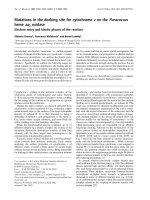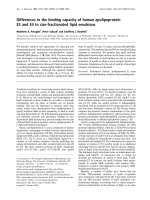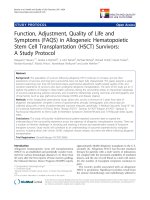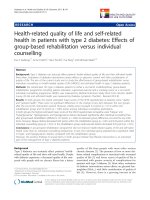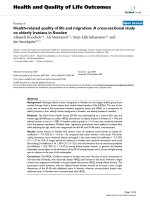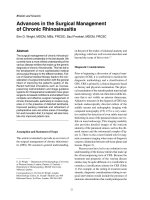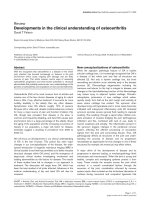Báo cáo y học: " Change in quality of life and their predictors in the long-term follow-up after group cognitive behavioral therapy for social anxiety disorder: a prospective cohort study" pptx
Bạn đang xem bản rút gọn của tài liệu. Xem và tải ngay bản đầy đủ của tài liệu tại đây (250.07 KB, 10 trang )
RESEARC H ARTIC LE Open Access
Change in quality of life and their predictors in
the long-term follow-up after group cognitive
behavioral therapy for social anxiety disorder:
a prospective cohort study
Norio Watanabe
1*
, Toshi A Furukawa
1
, Junwen Chen
1
, Yoshihiro Kinoshita
1
, Yumi Nakano
1
, Sei Ogawa
1
,
Tadashi Funayama
1
, Tetsuji Ietsugu
2
, Yumiko Noda
1
Abstract
Background: Social anxiety disorder (SAD) is one of the most common anxiety disorders. The efficacy of cognitive
behaviour therapy (CBT) has been examined but to date its effects on Quality of Life (QoL) have not been
appropriately evaluated especially in the long term.
The study aimed to examine, in the long term, what aspects of Quality of Life (QoL) changed among social anxiety
disorder (SAD) patients treated with group cognitive behaviour therapy (CBT) and what predictors at baseline were
associated with QoL.
Methods: Outpatients diagnosed with SAD were enrolled into group CBT, and assessed at follow-ups for up to
12 months in a typical clinical setting. QoL was evaluated using the Short Form 36. Various aspects of SAD
symptomatology were also assessed. Each of the QoL domains and scores on symptomatology were quantified
and compared with those at baseline. Baseline predictors of QoL outcomes at follow-up were investigated.
Results: Fifty-seven outpatients were enrolled into group CBT for SAD, 48 completed the whole program, and 44
and 40 completed assessments at the 3-month and 12-month follow-ups, respectively. All aspects of SAD
symptomatology and psychological subscales of the QoL showed statistically significant improvement throughout
follow-ups for up to 12 months. In terms of social functioning, no statistically significant improvement was
observed at either follow-up point except for post-treatment. No consistently significant pre-treatment predictors
were observed.
Conclusions: After group CBT, SAD symptomatology and some aspects of QoL improved and this improvement
was maintained for up to 12 months, but the social functioning domain did not prove any significant change
statistically. Considering the limited effects of CBT on QoL, especially for social functioning, more powerful
treatments are needed.
Background
Social anxiety disorder (SAD), also known as social pho-
bia, is one of the most common psychiatric disorders,
with a 12-month and lifetime preval ence of 7% [1] and
12% [2], respectively. SAD typically begins during the
early teenage years and has a chronic course [2]. For
example, prospective, long-term, naturalistic studies
have indicated that only one-third of individuals attain
remission from SAD within 8 years [3]. People with
SAD are also at great risk for comorbid depression [4,5]
and other anxiety disorders [6].
SAD is associated with significant disability and dimin-
ished quality of life (QoL) [7,8], which refers not only to
one’s subjective judgment of the satisfaction with every-
day life, but also to objective indicators such as health
status and external life situations [9]. Diagnostic-specific
* Correspondence:
1
Department of Psychiatry and Cognitive-Behavioral Medicine, Nagoya City
University Graduate School of Medical Sciences, Nagoya, Japan
Full list of author information is available at the end of the article
Watanabe et al. BMC Psychiatry 2010, 10:81
/>© 2010 Watanabe et al; licensee BioMed Central Ltd. This is an Open Access article distributed under the terms of the Creative
Commons Attribution License ( which permits unrestricted use, distribution, and
reproduction in any medium, provided the original work i s pro perly cited.
symptom measures for anxiety disorders explained only a
small proportion of the variance in QoL [10,11], suggest-
ing that an individual’s perception of quality of life is an
additional factor that should be part of a complete assess-
ment. Depressive comorbidity in SAD contributes only
modestly to the deterioration in QoL [8].
With regards to treatment for SAD, a large number of
randomized controlled trials (RCTs) have investigated
the efficacy of various types of pharmacotherapy and
psychosocial intervention, and SAD is now regarded as
a treatable condition [12]. According to meta-analyses,
selective serotonin reuptake inhibitors (SSRIs) had a
mean effect size between 1.3 and 1.9 in symptomatology
scales in compa rison with placebo [13], while cognitive
behavioural therapy (CBT) encompassing exposure ther-
apy and cognitive restructuring had a mean effect size
of 0.8 in comparison with waiting list control [14].
QoL can also be improved with active treatment. In
comparison with patients treated with placebo pills,
several RCTs reported improvements in some QoL mea-
sures after treatment w ith a variety of antidepressants
[15-17]. In terms of psychotherapy, improvements in
some QoL measures have been reported in RCTs inves-
tigating the efficacy of CBT and subsequen t social skills
training [18], individual cognitive therapy [19], exposure
therapy [20], internet-based CBT plus in vivo exposure
[21], and internet-delivered CBT alone [22].
However, these studies have several limitations. First,
studies on QoL in the longer term after psychosocial ther-
apy are scarce, although SAD typically has a chronic
course [2], and evaluations of treatment outcomes must
consider the durability of gains after initial progress has
been achieved. Second, QoL has often been reported by
being aggregated into one [19,21,22] or two scales (mental
health and physical health subscales) [20], but assessment
of QoL has been reported that it should comprise at least
the following four domains: physical functional status, dis-
ease and treatment-related physical symptoms, psychologi-
cal functioning and social func tioning [23]. Actually, a
previous study [24] investigating QoL domains Short
Form 36 [25] in college students reported those with social
phobia were significantl y associated with lower quality of
life, particularly in general health, vitality, social function-
ing, role functioning-emotional, and mental health dimen-
sions. Third, to date, predictors for bet ter outcomes in
QoL in the long-term after CBT have not been established,
although several factors including sex and subtype of SAD
were found to be associated with better outcomes in SAD
symptomatology in one study [26].
We therefore aimed to examine: 1) what aspects of
QoL change during long-term follow-up after group
CBT in a typical clinical setting in a psychiatric clinic;
2) whether changes in the severity of symptomatology of
SAD are directly associated with QoL at long-term
follow-up;and3)whatpredictorsatbaselineareasso-
ciated with QoL in the long-term after group CBT.
We hypothesized that the improvement in QoL in the
long-term after CBT would be: 1) shown in both psy-
chol ogical and social funct ioning domains; 2) associated
with improvement in SAD symptomatology in the long
term as well as in the short term; 3) and associated with
low severity o f SAD symptomatology, non-generalized
SAD and good family support at baseline.
Methods
Patients
Details of the inclusion criteria for the participants and
the contents of the group CBT as an acute-phase treat-
ment have been described elsewhere [27]. In brief, 57
consecutive patients with SAD were initially recruited
into the outpatient group-based CBT program at the
Department of Psychiatry and Cogniti ve-Behavioral
Medicine,NagoyaCityUniversityHospital,Japan,
between February 2005 a nd May 2007. Some of the
patients were referred from mental health professionals
and others sought treatment themselves.
All patients were diagnosed with DSM-IV SAD as the
primary disorder using the Structured Clinical Interview
for DSM-IV [28]. All patients also fulfilled the following
criteria: (a) absence of a history of psychosis or bipolar
disorder or of current substance use disorder; (b) no pre-
vious CBT treatments and no any other additional struc-
tured psychosocial therapies during the treatment period;
and (c) absence of Cluster B personality disorders.
Patients with current major depressive disorder, other
current anxiety disorders and Cluster A and C personal-
ity disorders were included, when these symptoms abated
sufficiently to allow them to attend the group CBT
sessions regularly, judged by their physicians.
The patients provided their written informed consent
aft er a full explanation of t he objectives and procedures
of the present study. The study protocol was approved
by the Ethics Committee of the Nagoya City University
Graduate School of Medical Sciences.
Treatment
The CBT program consisted of 12 or more, two-hour,
group sessions, with the number of sessions depending
on each group’s progress (maximum 20 sessions), and
was based on Andrews et al’s treatment manual [29].
The main components included psychoeducation,
attention training, video-feedback of role-plays, beha-
vioural experiments, cognitive restructuring and
optional self-assertion training. Homework was actively
tailored for each patient through collaboration of
therapists and patients according to contents in each
session, assigned after every session, and reviewed in
subsequent sessions.
Watanabe et al. BMC Psychiatry 2010, 10:81
/>Page 2 of 10
The patients were treated in groups of 3 or 4 led by
two therapists (one principal and one co-thera pist).
Eight therapists (five psychiatrists and three doctoral-
level clinical psychologists) each with more than three
years of clinical practice and experience in treatment of
anxiety disorders conducted the treatment program,
guided by a therapists ’ manual. During the treatment,
the therapists had group discussions once a month to
check on therapist adherence to the program and to
plan for future sessions.
During and after the CBT, co-administration of anti-
depressants and benzodiazepines was allowed as a part
of usual treatment at a specialist clinic, because the pre-
sent study was intended to reflect the outcomes of a
typical clinical setting. No patient participated in other
structured psychosocial treatments or other clinical
research into SAD.
Assessment
Demographic and diagnostic characteristics of the
patients were gathered at baseline, including sociodemo-
graphic factors such as sex, age, education, marital status,
living situation and employment status. Information
about age of onset and duration of SAD, subtypes of
SAD, psychiatric comorbidity (especially avoidant per-
sonality disorder) and medication use were also obtained.
The patients were assessed with an extensive question-
naire batte ry using observer-rat ed assessments and self-
report questionnaires at baseline, post-treatment and at
3- and 12-month follow-ups. In addition to a question-
naire measuring various aspec ts of QoL, questionnaires
on SAD symptomatology, including depression, were
administered at each time point.
QoL was assessed using the Short Form 36 (SF-36)
and severity of SAD was assessed using the Social Pho-
bia Scale (S PS) and the Social Intera ction Anxiety
(SIAS). Depression was assessed as one aspect of SAD
symptomatology using the Symptom Checklist-90-
Revised (SCL-90-R).
Short Form 36 (SF-36)
The Japanese version of the Short Form 36 (SF-36
version 1.2) was used to assess QoL. The SF-36 [25] is a
36-item self-report questionnaire and is among the most
frequently-used measures to evaluate health-related
QoL. The SF-36 addresses both physical and emotional
health states and provides validated scores indicating
health variations in eight domains: physical functioning,
role physical, bodily pain, general health perception,
vitality, social functioning, role emotional and mental
health. Each domain is scored from 0 to 100, with a
higher score indicating better function. The SF-36 is
thought to be able to address all necessary factors to
measure QoL comprehensively [23]. The Japanese
version had already been developed and validated [30].
Social Phobia Scale and Social Interaction
Anxiety (SPS/SIAS)
The SPS and the SIAS [31] are 20-item self-report ques-
tionnaires. The SPS was designed to measure the fear of
being observed, whereas the SIAS provides a measure of
fear of social interaction. The items are rated on a
4-point scale from 0 (not at all characteristic or true of
me) to 4 (extremely characteristic or true of me), with
scores for each scale ranging from 0 to 80 and a higher
score indicating a worse condition. Excellent internal
consistency and reliability and sufficient predictive and
concurrent validity have been demonstrated for both
Japanese versions [32].
Symptom Checklist-90-Revised (SCL-90-R)
The SCL-90-R is a 90-item questionnaire widely used to
assess general psychopathology [33]. A higher sc ore
indicates worse status for each dimension. The reliability
and validity o f the Japanese version have been demon-
strated [34]. We used the depression subscale of this
comprehensive psychology scale.
Statistical analysis
All patients who completed the group CBT and whose
data were obtained at the fo llow-ups were included in
the analyses. All analyses were conducted as completer
analyses, where data from patients who completed the
post-treatment and follow-up assessments were consid-
ered. An intent ion-to-treat analysis, where data from all
patientswhowereenrolledintothestudywereconsid-
ered, was not conducted, but we performed one-way
ANOVA for continuous variables or c
2
tests for catego-
rical variables to compare QoL, demographic data and
SAD symptomatology between completers and dropouts
from the program or follow-up assessments.
All the statistical tests were two-tailed, and an alpha
value of less than 0.05 was considered statistically signif-
icant. Results with an alpha value of less than 0.005
were also identified, since multiple tests were conducted
in the analysis and we did not use any formal methods
to correct this, given that the stud y is t he first detailed,
systematic evaluation of QoL domains in the long t erm
and was therefore considered to be an exploratory study.
All the data were analyzed using SPSS 16.0 for
Windows [35].
Changes in symptoms and QoL through the treatment and
follow-ups
The outcomes of the CBT program for the patients with
SAD were qualified using paired t-tests between pre-
treatment and each follow-up time point (post-treat-
ment and 3- and 12-month follow-ups) in terms of the
QoL scores (eight domains of the SF-36) as well as the
SAD symptomatology scores (SPS, SIAS and SCL-90-R
depression status). The magnitude of any differences
was calculated as an effect size [(mean follow-up - mean
Watanabe et al. BMC Psychiatry 2010, 10:81
/>Page 3 of 10
pre-treatment)/pooled SD] with 95% confidence inter-
vals. Effect sizes are usually categorized as follows: small
(0.20-0.49), medium (0.50-0.79), and large effects (0.80
and above) [36].
Correlation between changes in SAD symptomatology and
those in QoL
Tests of correlation were undertaken and Pearson’ s r
was calculated with the differences between pre-treat-
ment and each follow- up time point (pot-treatment and
3- and 12-month follow-ups) on the eight domain-
scores of the SF-36 and the symptomatological measures
of SAD.
Potential predictors at baseline for changes in QoL at
follow-ups
In order to elucidate the baseline predictors of the treat-
ment outcomes at post-treatment and the 3- and
12-month follow-ups, multiple regression analyses using
a stepwise method (probability of F to enter, ≤ 0.50; to
remove, ≥0.10) were conducted with the eight domain
scores of the SF-36 at each time point as dependent
variables and the baseline demographic and clinical vari-
ables as independent var iables, controlling for the base-
line SF-36 score.
Results
Demographic and clinical characteristics of the patients
Fifty-seven outpatients were initially enrolled into group
CBT (Table 1). No patients satisfied the diagnostic cri-
teria of avoidant personality disorder according to
DSM-IV. Of these enrolled into the CBT program, 48
completed the program, and 44 and 40 completed the
assessments at the 3-month and 12-month follow-ups,
respectively. The demographic characteristics, SAD
symptomatology and QoL at baseline did not signifi-
cantly differ among patients who dropped out during
the CBT program or follow-up prematurely, apart from
living situation (Table 1).
Changes in symptoms and QoL through the treatment
and follow-ups
Examination of changes in all the S AD symptomatology
measures between pre-treatment and each subsequent
time point revealed signifi cant improvement not only at
post-treatment but also up to 12-month follow-up, with
an effect size of -0.96 (large effect) on SPS, of -0.87
(large effect) on SIAS and of -0.45 (small effect) on
SCL-90-R depression at 12-month follow-up (Table 2).
In terms of the QoL domains, general health perception,
vitality and mental health were statistically significantly
better post-treatment and these improvements were
maintained for up to 12 months of follow-up, with an
effect size of 0.44 (small effect), of 0.29 (small effect),
and of 0.32 (small effect) at 12-month follow-up, respec-
tively. However, in terms of social functioning, no
statistically significant improvement was observed at
follow-up apart from at post-treatment with an effect
size of 0.30 (small effect).
Correlation between changes in SAD symptomatology
and those in QoL
Changes in the total scores of each of the SAD sympto-
mato logy measures significant ly co rrelated with changes
in the mental health domain score throughout the
follow-up period, with a Pearson’ s r of around -0.5
(Table 3). Change in the SIAS score was significantly
associated with change in the role emotional domain
through the entire period of follow-up, with a Pearson’s
r of around -0.35, whilst those in the SPS score and th e
depression score were associated with that of role emo-
tional only at post-treatment. In contrast, the change in
the SPS score was significantly associated with the
change in the social functioning domain not at post-
treatment but at the 3- and 12-month follow-ups, with a
Pearson’ s r of around -0.4, whilst the changes in the
SIAS score and depression score were associated with
changes in social functioning only at post-treatment.
Potential predictors at baseline for changes in QoL at
follow-ups
None of the symptomatology scores for SAD at baseline
were significant predictors of social functioning post-
treat ment or at 3 months, but all were significant predic-
tors at 12 months (Table 4). Depression at baseline was
significantly associated with the role emotional domain
throughout follow-up, apart from at post-treatment. No
significant pre-treatment predictors thro ughout the
entire period of follow-up were identified for any of the
QoL outcomes.
Discussion
Main findings
To our knowledge, this is the first detailed evaluation of
long-term QoL after a CBT program for SAD. We
assessed patients for up to 12 months after the cessation
of group CBT provided in a t ypical clinical sett ing. The
study revealed several important findings.
First, SAD symptomatology and some aspects of QoL
did improve and these improvements were maintained
for at least 12 months a fter group C BT. However, the
improvement in the social functioning domain of the
SF-36, which was noted post-treatment, was not main-
tained over the 12 months of follow-up.
Second, social functioning at follow-up through to
12 months was not always associated with improvements
in SAD symptomatology, especially the SIAS. A previous
study of group CBT concluded that QoL in one aggre-
gated scale post-treatment was associated with the SIAS
among patients diagnosed with social phobia [37].
Watanabe et al. BMC Psychiatry 2010, 10:81
/>Page 4 of 10
Table 1 Demographic and clinical characteristics of the patients at baseline
Patients who
entered the CBT but
did not complete
Patients who completed
the CBT but not the 3-
month FU assessments
Patients who completed the
the 3-month but not the 12-
month FU assessments
Patients who
provided both
FU assessments
P
value
Number of subjects 9 4 4 40
Female, No. (%) 3 (33.3) 2 (50.0) 2 (50.0) 23 (57.5) 0.63
Age, years
Mean ± SD 27.4 ± 8.8 34.2 ± 9.3 34.2 ± 9.3 34.2 ± 8.9 0.12
Range 18-47 18-52 18-52 18-52
Onset of SAD, years
Mean ± SD 17.1 ± 4.2 19.4 ± 7.8 19.4 ± 7.8 19.6 ± 7.8 0.12
Range 12-23 5-42 5-42 5-42
Living situation, No (%) 0.03*
With spouse/
significant-other
0 (0.0) 1 (25.0) 2 (50.0) 20 (50.0)
With parents 5 (55.6) 3 (75.0) 2 (50.0) 16 (40.0)
Alone 4 (44.4) 0 (0.0) 0 (0.0) 4 (10.0)
Employment 0.61
Full-time employment 2 (22.2) 1 (25.0) 1 (25.0) 10 (25.0)
Full-time student 2 (22.2) 0 (0.0) 0 (0.0) 2 (5.0)
Part-time/homemaker/
retired
3 (33.3) 2 (50.0) 3 (75.0) 23 (55.0)
Unemployed 2 (22.2) 1 (25.0) 0 (0.0) 6 (15.0)
Education, No. (%) 0.61
University 2 (22.2) 1 (25.0) 1 (25.0) 15 (37.5)
College 1 (11.1) 3 (75.0) 1 (25.0) 10 (25.0)
High school or less 6 (66.6) 0 (0.0) 2 (50.0) 15 (37.5)
Social phobia, No. (%)
generalized
8 (88.8) 4 (100.0) 3 (75.0) 34 (85.0) 0.72
Comorbidity, No. (%)
Mood disorders 2 (22.2) 4 (100.0) 2 (50.0) 14 (35.0) 0.05
Anxiety disorders 1 (11.1) 1 (25.0) 0 (0.0) 4 (10.0) 0.71
Medication, No. (%)
Benzodiazepine 4 (44.4) 0 (0.0) 1 (25.0) 11 (27.5) 0.20
Antidepressant 7 (77.8) 2 (50.0) 2 (50.0) 20 (50.0) 0.50
SF-36
Physical functioning 85.6 ± 14.7 91.3 ± 11.8 82.5 ± 22.2 88.6 ± 14.3 0.79
Role-physical 75.0 ± 43.3 62.5 ± 43.3 56.3 ± 51.5 68.6 ± 36.6 0.87
Bodily pain 90.3 ± 19.4 64.3 ± 29.4 66.5 ± 32.5 65.8 ± 25.3 0.08
General health
perception
47.2 ± 22.4 49.8 ± 26.3 44.3 ± 26.3 45.1 ± 22.1 0.98
Vitality 42.2 ± 23.6 45.0 ± 5.8 20.0 ± 18.3 39.6 ± 21.1 0.28
Social functioning 45.8 ± 23.4 56.3 ± 21.7 65.6 ± 38.7 58.7 ± 30.2 0.63
Role-emotional 51.9 ± 44.4 50.0 ± 43.0 41.7 ± 50.0 57.3 ± 40.4 0.89
Mental health 44.9 ± 14.9 48.0 ± 3.3 36.0 ± 15.0 47.9 ± 20.5 0.67
SPS (total) 44.0 ± 13.7 47.3 ± 28.0 34.0 ± 6.2 33.7 ± 12.5 0.08
SIAS (total) 55.3 ± 9.8 64.5 ± 26.4 51.3 ± 11.2 51.0 ± 13.3 0.29
SCL-90-R depression 1.67 ± 0.96 1.52 ± 0.75 1.35 ± 0.89 1.50 ± 0.87 0.93
P-values were calculated using one-way ANOVA for continuous variables and using c
2
statistic for categorical variables.
Appendices: FU, follow-up; SAD, social anxiety disorder; SCL-90-R, Symptom Checklist-90-Revised; SF-36 , Short Form 36; SIAS, Social Interaction Anxiety; SPS, Social
Phobia Scale.
(* P < 0.05, ** P < 0.005).
Watanabe et al. BMC Psychiatry 2010, 10:81
/>Page 5 of 10
Table 2 Mean symptom scores at follow-ups and effect sizes in comparison with those at baseline
Pre-treatment Post-treatment 3-month FU 12-month FU
Number of the patients 57 48 44 40
SF-36
Physical functioning Score 87.9 (14.5) 89.8 (14.5) 89.3 (15.4) 90.6 (14.8)
ES 0.10 (-0.32, 0.51) 0.02 (-0.41, 0.46) 0.15 (-0.30, 0.59)
Role-physical Score 68.3 (38.3) 72.8 (34.5) 78.0 (35.0) 81.9 (31.5)*
ES 0.06 (-0.36, 0.48) 0.27 (-0.17, 0.70) 0.39 (-0.06, 0.84)
Bodily pain Score 69.7 (26.1) 70.8 (21.8) 75.1 (23.9)* 67.3 (24.6)
ES 0.24 (-0.19, 0.65) 0.32 (-0.12, 0.75) 0.12 (-0.32, 0.57)
General health perception Score 45.7 (22.1) 53.2 (22.3)* 54.3 (24.7)* 55.1 (24.4)*
ES 0.28 (-0.14, 0.70) 0.35 (-0.09, 0.78) 0.44 (-0.02, 0.89)
Vitality Score 39.0 (21.0) 49.2 (17.8)** 46.5 (24.6)** 45.3 (22.4)*
ES 0.51 (0.08, 0.93) 0.36 (-0.08, 0.79) 0.29 (-0.17, 0.74)
Social functioning Score 56.9 (29.1) 68.6 (29.6)* 67.3 (28.9) 66.3 (26.6)
ES 0.30 (-0.12, 0.72) 0.26 (-0.17, 0.70) 0.28 (-0.17, 0.72)
Role-emotional Score 54.8 (40.9) 61.5 (43.8) 67.5 (38.4) 60.8 (43.3)
ES 0.07 (-0.35, 0.49) 0.31 (-0.13, 0.75) 0.08 (-0.36, 0.52)
Mental health Score 46.6 (18.6) 54.4 (16.6)* 55.4 (21.3)* 54.7 (23.9)*
ES 0.39 (-0.04, 0.81) 0.40 (-0.04, 0.83) 0.32 (-0.13, 0.77)
SPS (total) Score 36.3 (14.2) 24.9 (14.8)** 20.4 (11.0)** 21.8 (12.7)**
ES -0.69 (-1.10, -0.28) -1.14 (-1.59, -0.68) -0.96 (-1.41, -0.50)
SIAS (total) Score 52.7 (13.9) 41.4 (15.6)** 37.8 (13.1)** 38.4 (15.5)**
ES -0.71 (-1.12, -0.29) -1.00 (-1.44, -0.54) -0.87 (-1.32, -0.41)
SCL-90-R depression Score 1.52 (0.86) 0.96 (0.75)** 1.08 (0.86)** 1.09 (0.97)**
ES -0.66 (-1.07, -0.24) -0.44 (-0.86, -0.01) -0.45 (-0.89, 0.00)
Scores are presented with SDs (in parentheses), and ESs with their 95% confidence intervals. ES calculations and paired t tests were conducted for completers at
each time point, by comparing scores with those at baseline.
Appendices: ES, effect size; FU, follow-up; SCL-90-R, Symptom Checklist-90-Revised; SF-36, Short Form 36; SIAS, Social Interaction Anxiety; SPS, Social Phobia Scale
(* P < 0.05, ** P < 0.005).
Table 3 Correlation between changes in SAD symptomatology and those in QoL between pre-treatment and follow-
ups
Post-treatment 3-month follow-up 12-month follow-up
Number of the patients 48 44 40
SPS SIAS SCL-90-R
Depression
SPS SIAS SCL-90-R
Depression
SPS SIAS SCL-90-R
Depression
SF-36
Physical functioning -0.32* -0.19 -0.33* -0.23 -0.18 -0.27 -0.09 -0.03 -0.05
Role-physical -0.13 -0.16 -0.12 -0.31* -0.22 -0.33* -0.12 -0.02 -0.10
Bodily pain -0.30 -0.17 -0.05 -0.51** -0.46** -0.31 -0.11 -0.19 0.07
General health
perception
-0.43** -0.41* -0.33* -0.53** -0.47** -0.47** -0.28 -0.26 -0.31
Vitality -0.16 -0.34* -0.44** -0.56** -0.64** -0.36* -0.43* -0.58** -0.36*
Social functioning -0.22 -0.35* -0.41* -0.37* -0.27 -0.48** -0.44* -0.17 -0.26
Role-emotional -0.45** -0.36* -0.41* -0.28 -0.36* -0.14 -0.24 -0.33* -0.22
Mental health -0.42* -0.53** -0.53** -0.52** -0.62** -0.50** -0.44* -0.54** -0.45*
Pearson’s rs are prese nted in the table.
Appendices: SCL-90-R, Symptom Checklist-90-Revised; SF-36, Short Form 36; SIAS, Social Interaction Anxiety ; SPS, Social Phobia Scale.
(* P < 0.05, ** P < 0.005).
Watanabe et al. BMC Psychiatry 2010, 10:81
/>Page 6 of 10
Table 4 Predictors at baseline for changes at follow-ups in QoL in SAD patients treated with CBT
Characteristics Post treatment 3-month follow-up 12-month follow-up
at baseline PF RP BP GH VT SF RE MH PF RP BP GH VT SF RE MH PF RP BP GH VT SF RE MH
Adjusted R-square 0.62 0.12 0.17 0.39 0.50 0.27 0.15 0.41 0.45 0.25 0.23 0.47 0.59 0.36 0.19 0.32 0.64 0.21 0.33 0.29 0.46 0.55 0.35 0.37
Age: 35 yrs or older aaaaaa0.41*aaaaaaaaaaaaaaa aa
Living situation a a a a -0.32** a a a a a a a a a a a a a a a a a a a
Employment aaaaaaaaaaaa-0.30* a a a a a a a a a a a
Generalized SAD -0.22* aaaaaa-0.28* a a a a a a a a a a a a a a a a
Benzodiazepine use 0.23* aaaaaaaaaaaaaaaaaaaaa aa
SPS (total) aaaaaaaaa0.39* a 0.29* a a a a a a a a a 0.49** a a
SIAS (total) aaaaaaaaaaaaaaaaaaaaa-0.32* a a
SCL-90-R depression a a -0.44** a a a a a a -0.64** a a a a -0.46** a a a a a a -0.41* -0.61** a
Table shows the standardized Beta coefficients, except for a row showing adjusted R-squares of the models. Sex, age of onset (20 years or older), marital status, education, comorbid mood or anxiety disorder, and
antidepressant use were entered but not selected in any regression models through application of a stepwise method.
a
Entered into the analysis but not selected in the multiple regression model through application of a stepwise method.
Appendices: PF, physical functioning; RP, role physical; BP, bodily pain; GH, general health perception; VT, vitality; SF, social functioning; RE, role emotional; MH, mental health; SAD, social anxiety disorder; SCL-90-R,
Symptom Checklist-90-Revised; SF-36, Short Form 36; SIAS, Social Interaction Anxiety; SPS, Social Phobia Scale.
(* P < 0.05, ** P < 0.005).
Watanabe et al. BMC Psychiatry 2010, 10:81
/>Page 7 of 10
Third, we hypothesized that a low severity of SAD
symptomatology, non-generalized SAD, and good family
support would be associated with better outcomes in
QoL, as suggested by previous research [26,37,38], but
no consistent pre-treatment predictors were detected for
any of the QoL domains throughout fol low-up for up to
12 months.
The most striking finding of the current study may be
that the social functioning domain, which is significantly
impaired in patients with SAD in comparison with the
general population [39], improved post-treatment, but
the degree of improvement was very small (effect size
on social functioning, 0.30) and w as not maintained at
follow-up, although scores of SAD symptomatology
were much improved (effect size, around 1.0). Attention
should be paid to this discrepancy between QoL and
SAD symptomatology, because patients may judge the
outcome of therap y based on their subjective feelings of
QoL while clinicians may judge outcome based on diag-
nostic and symptom measures [40]. A previous report
concluded that group CBT led to significant improve-
ment in the social functioning factor of a QoL scale in
SAD patients [41], but the magnitude of this improve-
ment was not reported. The effect size calculated by
using pre- and post-treatment scores and pre-test stan-
dard deviations of the social functioning factor in the
report was 0.40, which is similar to the value of the
effect size in our study, so we shoul d be cautious about
concluding that CBT o ffers promising improvements in
social functioning.
Considering the small and short-term effects of CBT
on QoL, especially for social functioning, more powerful
treatments are needed in clinical practice. Although a
previous study has reported that cognitive therapy with
no formal social skills training led to significantly more
improvement in SAD symptomatology than exposure
plus applied relaxation or wait-list did[42], no QoL out-
comes were reported in this study. Other treatment fac-
tors, such as social skills training, might have an
additional benefit to social functioning in the long term.
Future studies should place more focus on social func-
tioning rather than on SAD symptomatology.
Limitations
The present study is not without its methodological
limitations.
First, the study was conducted as a single-arm, naturalis-
tic, follow-up study and was no control condition was
used. An RCT with an appropriate control group is there-
fore needed to investigate the efficacy of treatment. More-
over, any antidepressant and benzodiazepine medications
were allowed at baseline. The info rmation about changes
in dosing were not collected. Medications might have had
an effect on the outcomes and this issue should be listed
among limitations, although most of the patients had suf-
fered from social anxiety disorders for more than 10 years
and had already been on medication for a long time. How-
ever, this study was intended to examine the long-term
consequences of CBT through natur alistic follow-up in a
typical clinical setting. We believe that the study design is
appropriate for this purpose.
Second, the sample size of th e study migh t have been
too small to identify statistically significant changes in the
domains of the SF-36 or to detect potential baseline pre-
dictors of the SF-36 at the follow-ups. Nevertheless, the
changes of each of the SAD symptomatology scores were
statistically significant, with an effect size of around 1.0.
The effect size of social functioning, which we hypothe-
sized would improve significantly, reached a maximum of
only 0.3 during follow-up, which must be considered a
small effect, if indeed there is any effect at all.
Third, one may argue that, instead of the SPS and SIAS,
a more frequently-used measure such as the Liebowitz
Social Anxiety Scale (LSAS) should have been used to
evaluate SAD symptomatology. The LSAS is a 24-item
scale that provides separate scores for fear and avoidance
of social interaction and performance situations, and the
Japanese version has sufficient validity data [43]. We did
not use it because assessments at the follow-ups were
done by patient self-evaluation and the LSAS requires an
assessor. Although one paper reported data supporting the
use of the LSAS as a self-reporting instrument [44], we
were not willing to use the LSAS in an unconventional
way because a self-reporting version has not yet been vali-
dated in Japan.
Fourth, a standard treatment manual [29] has been
adopted, we did not conduct any booster sessions after
the acute-phase treatment. This might have effect on
the fact that the improvement at post-treatment in the
social functioning d omain in t he SF-36 were not ma in-
tained over a 12-month follow-up period, although that
in SAD symptomatological outcomes were maintained.
Future studies might be needed to investigate the effi-
cacy of booster sessions on social functioning outcomes.
Conclusions
Symptomatology of SAD and some aspects of QoL
improved, and these improvements were maintained for
up to 12 months, after group CBT but the social func-
tioning domain did not significantly change. Better
treatments for SAD, focusing on improving social func-
tioning, are needed in clinical practice.
Acknowledgements
This study was supported by the Department of Psychiatry and Cognitive
Behavioral Medicine, Nagoya City University Graduate School of Medical
Sciences and also by a Grant-in-Aid from the Ministry of Health, Labor and
Welfare, Japan.
Watanabe et al. BMC Psychiatry 2010, 10:81
/>Page 8 of 10
Author details
1
Department of Psychiatry and Cognitive-Behavioral Medicine, Nagoya City
University Graduate School of Medical Sciences, Nagoya, Japan.
2
Nagoya
Keizai University Junior College, Inuyama, Aichi, Japan.
Authors’ contributions
NW conceived of the study, performed the clinical investigation (diagnosis,
treatment and assessment), and drafted the manuscript. TAF participated in
the design of the study and performed the clinical investigation. JC, YNa, YK,
SO, TF, TI, and YNo performed the clinical investigation. All authors read and
approved the final manuscript.
Competing interests
The authors declare that they have no competing interests.
Received: 5 November 2009 Accepted: 14 October 2010
Published: 14 October 2010
References
1. Kessler RC, Chiu WT, Demler O, Merikangas KR, Walters EE: Prevalence,
severity, and comorbidity of 12-month DSM-IV disorders in the National
Comorbidity Survey Replication. Archives of General Psychiatry 2005,
62(6):617-627.
2. Kessler RC, Berglund P, Demler O, Jin R, Merikangas KR, Walters EE: Lifetime
prevalence and age-of-onset distributions of DSM-IV disorders in the
National Comorbidity Survey Replication. Archives of General Psychiatry
2005, 62(6):593-602.
3. Keller MB: The lifelong course of social anxiety disorder: a clinical
perspective. Acta Psychiatrica Scandinavica Supplementum 2003(417):85-94.
4. Kessler RC, Stang P, Wittchen HU, Stein M, Walters EE: Lifetime co-
morbidities between social phobia and mood disorders in the US
National Comorbidity Survey. Psychol Med 1999, 29(3):555-567.
5. Beesdo K, Bittner A, Pine DS, Stein MB, Hofler M, Lieb R, Wittchen HU:
Incidence of social anxiety disorder and the consistent risk for
secondary depression in the first three decades of life. Archives of General
Psychiatry 2007, 64(8):903-912.
6. Chartier MJ, Walker JR, Stein MB: Considering comorbidity in social
phobia. Soc Psychiatry Psychiatr Epidemiol 2003, 38(12):728-734.
7. Wittchen HU, Fuetsch M, Sonntag H, Müller N, Liebowitz M: Disability and
quality of life in pure and comorbid social phobia. Findings from a
controlled study. European Psychiatry 2000, 15(1):46-58.
8. Stein MB, Kean YM: Disability and quality of life in social phobia:
epidemiologic findings. The American Journal of Psychiatry 2000,
157(10):1606-1613.
9. Dimenas ES, Dahlof CG, Jern SC, Wiklund IK: Defining quality of life in
medicine. Scandinavian Journal of Primary Health Care Supplement 1990,
1:7-10.
10. Rapaport MH, Clary C, Fayyad R, Endicott J: Quality-of-life impairment in
depressive and anxiety disorders. The American Journal of Psychiatry 2005,
162(6):1171-1178.
11. Barrera TL, Norton PJ: Quality of life impairment in generalized anxiety
disorder, social phobia, and panic disorder. Journal of Anxiety Disorders
2009, 23(8):1086-1090.
12. Schneier FR: Clinical practice. Social anxiety disorder. The New England
Journal of Medicine 2006, 355(10):1029-1036.
13. Hansen RA, Gaynes BN, Gartlehner G, Moore CG, Tiwari R, Lohr KN: Efficacy
and tolerability of second-generation antidepressants in social anxiety
disorder. Int Clin Psychopharmacol 2008, 23(3):170-179.
14. Acarturk C, Cuijpers P, van Straten A, de Graaf R: Psychological treatment
of social anxiety disorder: a meta-analysis. Psychol Med 2009,
39(2):241-254.
15. Kasper S, Stein DJ, Loft H, Nil R: Escitalopram in the treatment of social
anxiety disorder: randomised, placebo-controlled, flexible-dosage study.
The British Journal of Psychiatry 2005,
186:222-226.
16. Stein MB, Fyer AJ, Davidson JR, Pollack MH, Wiita B: Fluvoxamine
treatment of social phobia (social anxiety disorder): a double-blind,
placebo-controlled study. The American Journal of Psychiatry 1999,
156(5):756-760.
17. Stein MB, Liebowitz MR, Lydiard RB, Pitts CD, Bushnell W, Gergel I:
Paroxetine treatment of generalized social phobia (social anxiety
disorder): a randomized controlled trial. JAMA 1998, 280(8):708-713.
18. Cottraux J, Note I, Albuisson E, Yao SN, Note B, Mollard E, Bonasse F,
Jalenques I, Guerin J, Coudert AJ: Cognitive behavior therapy versus
supportive therapy in social phobia: a randomized controlled trial.
Psychotherapy and Psychosomatics 2000, 69(3):137-146.
19. Mortberg E, Clark DM, Sundin O, Aberg Wistedt A: Intensive group
cognitive treatment and individual cognitive therapy vs. treatment as
usual in social phobia: a randomized controlled trial. Acta Psychiatrica
Scandinavica 2007, 115(2):142-154.
20. Haug TT, Blomhoff S, Hellstrom K, Holme I, Humble M, Madsbu HP,
Wold JE: Exposure therapy and sertraline in social phobia: I-year follow-
up of a randomised controlled trial. The British Journal of Psychiatry 2003,
182:312-318.
21. Andersson G, Carlbring P, Holmstrom A, Sparthan E, Furmark T, Nilsson-
Ihrfelt E, Buhrman M, Ekselius L: Internet-based self-help with therapist
feedback and in vivo group exposure for social phobia: a randomized
controlled trial. Journal of Consulting and Clinical Psychology 2006,
74(4):677-686.
22. Carlbring P, Gunnarsdottir M, Hedensjo L, Andersson G, Ekselius L,
Furmark T: Treatment of social phobia: randomised trial of internet-
delivered cognitive-behavioural therapy with telephone support. The
British Journal of Psychiatry 2007, 190:123-128.
23. Aaronson NK, Bullinger M, Ahmedzai S: A modular approach to quality-of-
life assessment in cancer clinical trials. Recent Results in Cancer Research,
Fortschritte der Krebsforschung Progrès dans les Recherches sur le Cancer 1988,
111:231-249.
24. Ghaedi GH, Tavoli A, Bakhtiari M, Melyani M, Sahragard M: Quality of life in
college students with and without social phobia. Social Indicators
Research 2010, 97(2):247-256.
25. McHorney CA, Ware JE Jr, Lu JF, Sherbourne CD: The MOS 36-item Short-
Form Health Survey (SF-36): III. Tests of data quality, scaling
assumptions, and reliability across diverse patient groups. Medical Care
1994, 32(1):40-66.
26. Liebowitz MR, Heimberg RG, Schneier FR, Hope DA, Davies S, Holt CS,
Goetz D, Juster HR, Lin SH, Bruch MA, et al: Cognitive-behavioral group
therapy versus phenelzine in social phobia: long-term outcome.
Depression and Anxiety 1999, 10(3):89-98.
27. Chen J, Nakano Y, Ietzugu T, Ogawa S, Funayama T, Watanabe N, Noda Y,
Furukawa TA: Group cognitive behavior therapy for Japanese patients
with social anxiety disorder: preliminary outcomes and their predictors.
BMC Psychiatry 2007, 7:69.
28. First MB, Spitzer RL, Gibbon M, Williams JB: Structured Clinical Interview
for DSM-IV axis I Diosrders. Washington, D. C.: American Psychiatric Press
1997.
29. Andrews G, Creamer M, Crino R, Hunt C, Lampe L, Page A: The Treatment
of Anxiety Disorders: Clinician Guides and Patient Manuals. Cambridge:
Cambridge University Press, 2 2002.
30. Fukuhara S, Bito S, Green J, Hsiao A, Kurokawa K: Translation, adaptation,
and validation of the SF-36 Health Survey for use in Japan. Journal of
Clinical Epidemiology 1998, 51(11):1037-1044.
31. Mattick RP, Clarke JC: Development and validation of measures of social
phobia scrutiny fear and social interaction anxiety. Behaviour Research
and Therapy 1998, 36(4):455-470.
32. Kanai Y, Sasakawa S, Chen J, Suzuki S, Shimada H, Sakano Y: Development
and validation of the Japanese version of Social Phobia Scale and Social
Interaction Anxiety Scale. Shingshin-Igaku (Japanese Journal of
Psychosomatic Medicine) 2004, 44:841-850.
33. Derogatis LR: SCL-90-R: Administration, Scoring and Procedures Manual-II
for the Revised Version and Other Instruments of the Psychopathology
Rating Scale Series. Towson: Clinical Psychometric Research, Inc. 1992.
34. Furukawa T, Nakanishi M, Sakurai A, Suzuki Y, Suzuki-Moore A, Hamanaka T:
Effects of ethyl loflazepate in mood and neurosisrelated disorders (ICD-
10 JCM): Changes in SCL-90-R subscale scores. Rinsho Seishinigaku (Clinical
Psychiatry) 1996, 25:233-240.
35. SPSS Japan Inc: SPSS 16.0. Tokyo, Japan: SPSS Japan Inc., 16.0 2007.
36. Cohen J: Statistical power analysis in the behavioral sciences. Hillsdale,
NJ: Lawrence Erlbaum Assoc Inc. 1988.
37. Safren SA, Heimberg RG, Brown EJ, Holle C: Quality of life in social phobia.
Depression and Anxiety 1996, 4(3):126-133.
38. Stein MB, Chavira DA: Subtypes of social phobia and comorbidity with
depression and other anxiety disorders. Journal of Affective Disorders 1998,
50(Suppl 1):S11-16.
Watanabe et al. BMC Psychiatry 2010, 10:81
/>Page 9 of 10
39. Simon NM, Otto MW, Korbly NB, Peters PM, Nicolaou DC, Pollack MH:
Quality of life in social anxiety disorder compared with panic disorder
and the general population. Psychiatric Services 2002, 53(6):714-718.
40. Hollandsworth JG: Subjective well-being and behavior therapy:
Challenge, opportunity, or dead end? The Behavior Therapist 1987,
10:65-68.
41. Eng W, Coles ME, Heimberg RG, Safren SA: Domains of life satisfaction in
social anxiety disorder: relation to symptoms and response to cognitive-
behavioral therapy. Journal of Anxiety Disorders 2005, 19(2):143-156.
42. Clark DM, Ehlers A, Hackmann A, McManus F, Fennell M, Grey N,
Waddington L, Wild J: Cognitive therapy versus exposure and applied
relaxation in social phobia: A randomized controlled trial. J Consult Clin
Psychol 2006, 74(3):568-578.
43. Asakura S, Inoue S, Sasaki F, Sasaki Y, Kitagawa N, Inoue T, Denda K, Ito M,
Matsubara R, Koyama T: Reliability and Validity of the Japanese Version of
the Liebowitz Social Anxiety Scale. Seishin Igaku (Clinical Psychiatry) 2002,
44:1077-1084.
44. Baker SL, Heinrichs N, Kim HJ, Hofmann SG: The Liebowitz social anxiety
scale as a self-report instrument: a preliminary psychometric analysis.
Behaviour Research and Therapy 2002, 40(6):701-715.
Pre-publication history
The pre-publication history for this paper can be accessed here:
/>doi:10.1186/1471-244X-10-81
Cite this article as: Watanabe et al.: Change in quality of life and their
predictors in the long-term follow-up after group cognitive behavioral
therapy for social anxiety disorder: a prospective cohort study. BMC
Psychiatry 2010 10:81.
Submit your next manuscript to BioMed Central
and take full advantage of:
• Convenient online submission
• Thorough peer review
• No space constraints or color figure charges
• Immediate publication on acceptance
• Inclusion in PubMed, CAS, Scopus and Google Scholar
• Research which is freely available for redistribution
Submit your manuscript at
www.biomedcentral.com/submit
Watanabe et al. BMC Psychiatry 2010, 10:81
/>Page 10 of 10

